Effects of Exogenous Abscisic Acid on Bioactive Components and Antioxidant Capacity of Postharvest Tomato during Ripening
- PMID: 32188064
- PMCID: PMC7144105
- DOI: 10.3390/molecules25061346
Effects of Exogenous Abscisic Acid on Bioactive Components and Antioxidant Capacity of Postharvest Tomato during Ripening
Abstract
Abscisic acid (ABA) is a phytohormone which is involved in the regulation of tomato ripening. In this research, the effects of exogenous ABA on the bioactive components and antioxidant capacity of the tomato during postharvest ripening were evaluated. Mature green cherry tomatoes were infiltrated with either ABA (1.0 mM) or deionized water (control) and stored in the dark for 15 days at 20 °C with 90% relative humidity. Fruit colour, firmness, total phenolic and flavonoid contents, phenolic compounds, lycopene, ascorbic acid, enzymatic activities, and antioxidant capacity, as well as the expression of major genes related to phenolic compounds, were periodically monitored. The results revealed that exogenous ABA accelerated the accumulations of total phenolic and flavonoid contents; mostly increased the contents of detected phenolic compounds; enhanced FRAP and DPPH activity; and promoted the activities of PAL, POD, PPO, CAT, and APX during tomato ripening. Meanwhile, the expressions of the major genes (PAL1, C4H, 4CL2, CHS2, F3H, and FLS) involved in the phenylpropanoid pathway were up-regulated (1.13- to 26.95-fold) in the tomato during the first seven days after treatment. These findings indicated that ABA promoted the accumulation of bioactive components and the antioxidant capacity via the regulation of gene expression during tomato ripening.
Keywords: abscisic acid; antioxidant capacity; bioactive components; enzymatic activity; gene expression; tomato.
Conflict of interest statement
The authors declare no conflict of interest.
Figures
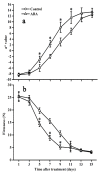
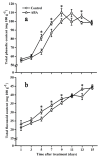


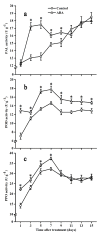


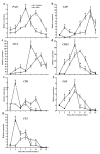

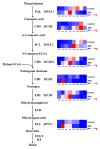
Similar articles
-
Contribution of abscisic acid to aromatic volatiles in cherry tomato (Solanum lycopersicum L.) fruit during postharvest ripening.Plant Physiol Biochem. 2018 Sep;130:205-214. doi: 10.1016/j.plaphy.2018.06.039. Epub 2018 Jun 30. Plant Physiol Biochem. 2018. PMID: 29990773
-
Strigolactone (GR24) regulates fruit ripening in yft3 tomatoes by altering ABA biosynthesis.Plant Sci. 2025 Jul;356:112484. doi: 10.1016/j.plantsci.2025.112484. Epub 2025 Mar 29. Plant Sci. 2025. PMID: 40164312
-
Bioactive compounds, folates and antioxidant properties of tomatoes (Lycopersicum esculentum) during vine ripening.Int J Food Sci Nutr. 2009 Dec;60(8):694-708. doi: 10.3109/09637480701833457. Int J Food Sci Nutr. 2009. PMID: 19919517
-
Genotypic variation in tomatoes affecting processing and antioxidant attributes.Crit Rev Food Sci Nutr. 2015;55(13):1819-35. doi: 10.1080/10408398.2012.710278. Crit Rev Food Sci Nutr. 2015. PMID: 24279355 Review.
-
Interactions of ABA signaling core components (SlPYLs, SlPP2Cs, and SlSnRK2s) in tomato (Solanum lycopersicon).J Plant Physiol. 2016 Oct 20;205:67-74. doi: 10.1016/j.jplph.2016.07.016. Epub 2016 Aug 27. J Plant Physiol. 2016. PMID: 27626883 Review.
Cited by
-
Influence of Combinations of Chemical and Organic Fertilizers on Biochemical Responses of Tomato Fruits in Different Maturity Stages.ACS Omega. 2025 Jul 14;10(28):30599-30615. doi: 10.1021/acsomega.5c02531. eCollection 2025 Jul 22. ACS Omega. 2025. PMID: 40727750 Free PMC article.
-
Transcriptomic, metabolomic, and ATAC-seq analysis reveal the regulatory mechanism of senescence of post-harvest tomato fruit.Front Plant Sci. 2023 Mar 8;14:1142913. doi: 10.3389/fpls.2023.1142913. eCollection 2023. Front Plant Sci. 2023. PMID: 36968400 Free PMC article.
-
Exogenous Abscisic Acid Mediates Berry Quality Improvement by Altered Endogenous Plant Hormones Level in "Ruiduhongyu" Grapevine.Front Plant Sci. 2021 Oct 1;12:739964. doi: 10.3389/fpls.2021.739964. eCollection 2021. Front Plant Sci. 2021. PMID: 34659307 Free PMC article.
-
Biosynthetic Mechanisms of Plant Chlorogenic Acid from a Microbiological Perspective.Microorganisms. 2025 May 13;13(5):1114. doi: 10.3390/microorganisms13051114. Microorganisms. 2025. PMID: 40431287 Free PMC article. Review.
-
Benzylaminopurine and Abscisic Acid Mitigates Cadmium and Copper Toxicity by Boosting Plant Growth, Antioxidant Capacity, Reducing Metal Accumulation and Translocation in Bamboo [Pleioblastus pygmaeus (Miq.)] Plants.Antioxidants (Basel). 2022 Nov 24;11(12):2328. doi: 10.3390/antiox11122328. Antioxidants (Basel). 2022. PMID: 36552536 Free PMC article.
References
-
- Dorais M., Ehret D.L., Papadopoulos A.P. Tomato (Solanum lycopersicum) health components: From the seed to the consumer. Phytochem. Rev. 2008;7:231–250. doi: 10.1007/s11101-007-9085-x. - DOI
-
- Del Rio D., Rodriguez-Mateos A., Spencer J.P.E., Tognolini M., Borges G., Crozier A. Dietary (poly)phenolics in human health: Structures, bioavailability, and evidence of protective effects against chronic diseases. Antioxid. Redox Signal. 2013;18:1818–1892. doi: 10.1089/ars.2012.4581. - DOI - PMC - PubMed
MeSH terms
Substances
Grants and funding
LinkOut - more resources
Full Text Sources
Medical
Miscellaneous

